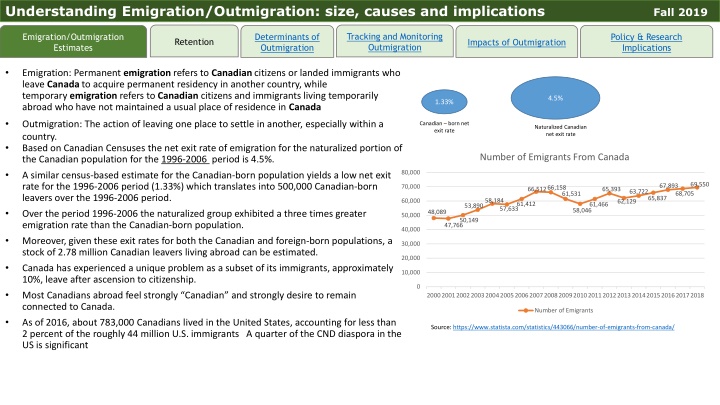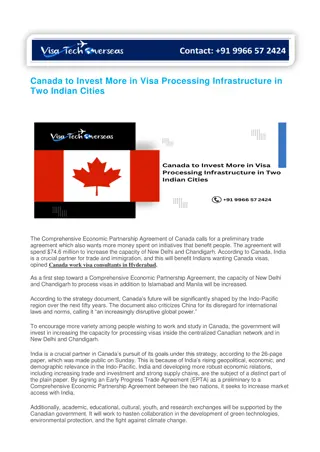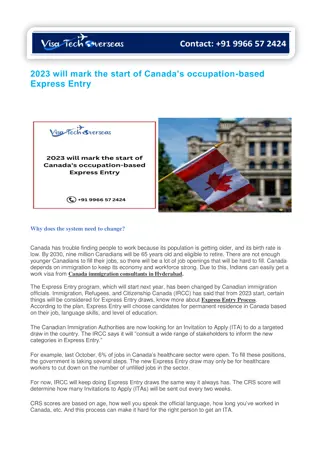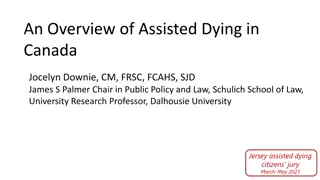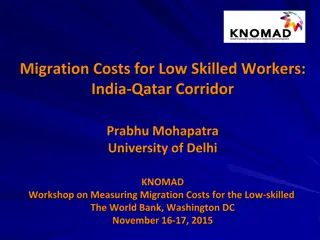Emigration Trends and Implications in Canada
Understand the size, causes, and effects of emigration in Canada, focusing on outmigration patterns, retention rates, and the impacts on different provinces. Explore the factors influencing emigration decisions and the policy implications for Canada's population dynamics.
Download Presentation

Please find below an Image/Link to download the presentation.
The content on the website is provided AS IS for your information and personal use only. It may not be sold, licensed, or shared on other websites without obtaining consent from the author.If you encounter any issues during the download, it is possible that the publisher has removed the file from their server.
You are allowed to download the files provided on this website for personal or commercial use, subject to the condition that they are used lawfully. All files are the property of their respective owners.
The content on the website is provided AS IS for your information and personal use only. It may not be sold, licensed, or shared on other websites without obtaining consent from the author.
E N D
Presentation Transcript
Understanding Emigration/Outmigration: size, causes and implications Fall 2019 Tracking and Monitoring Outmigration Emigration/Outmigration Estimates Determinants of Outmigration Policy & Research Implications Retention Impacts of Outmigration Emigration: Permanent emigration refers to Canadian citizens or landed immigrants who leave Canadato acquire permanent residency in another country, while temporary emigration refers to Canadian citizens and immigrants living temporarily abroad who have not maintained a usual place of residence in Canada 4.5% 1.33% Outmigration: The action of leaving one place to settle in another, especially within a country. Based on Canadian Censuses the net exit rate of emigration for the naturalized portion of the Canadian population for the 1996-2006 period is 4.5%. Canadian born net exit rate Naturalized Canadian net exit rate Number of Emigrants From Canada 80,000 A similar census-based estimate for the Canadian-born population yields a low net exit rate for the 1996-2006 period (1.33%) which translates into 500,000 Canadian-born leavers over the 1996-2006 period. 69,550 67,893 70,000 66,51266,158 65,393 63,722 68,705 61,531 65,837 53,89058,184 60,000 62,129 57,63361,412 61,466 58,046 48,089 Over the period 1996-2006 the naturalized group exhibited a three times greater emigration rate than the Canadian-born population. 50,000 50,149 47,766 40,000 Moreover, given these exit rates for both the Canadian and foreign-born populations, a stock of 2.78 million Canadian leavers living abroad can be estimated. 30,000 20,000 Canada has experienced a unique problem as a subset of its immigrants, approximately 10%, leave after ascension to citizenship. 10,000 0 Most Canadians abroad feel strongly Canadian and strongly desire to remain connected to Canada. 2000200120022003200420052006200720082009201020112012201320142015201620172018 Number of Emigrants As of 2016, about 783,000 Canadians lived in the United States, accounting for less than 2 percent of the roughly 44 million U.S. immigrants A quarter of the CND diaspora in the US is significant Source: https://www.statista.com/statistics/443066/number-of-emigrants-from-canada/
Understanding Emigration/Outmigration: size, causes and implications Fall 2019 Tracking and Monitoring Outmigration Emigration/Outmigration Estimates Determinants of Outmigration Policy & Research Implications Retention Impacts of Outmigration The province with the highest retention rate is Ontario, followed by Alberta, British Columbia and Quebec. Ontario, Quebec, Alberta and British Columbia have retention rates of skilled workers above 85%. Similarly for provincial nominees, Ontario and provinces to the west had retention rates above 80%. In terms of immigration categories, live-in caregivers, refugees, and the family class have highest retention rates (90%) while retention rates for skilled workers and provincial nominees were somewhat lower (between 80 and 85%). When net change is taken into account, Alberta stands out because it was the recipient of so many secondary movers (a net increase of more than 16,500 over the 6 year period). The Atlantic region is diverse and each province is chart on its own path to accommodate its unique needs through Provincial Nominee Programs. Nova Scotia has the highest regional five-year retention rate at 72%, Newfoundland and Labrador is at 56 %, New Brunswick is at 52% and |PEI is at 18% overall . PEI s retention rate fell from 32.3% in TY 2011 to 27.8% (tax year 2013) and the net inflow rate for 2013 (30.9%) is also lower than it was in 2011 (37.3%). This means that PEI retains significantly less than 1/3 of the immigrants originally destined there, which is problematic for a province where Provincial Nominees account for about 90% of annual flow of new permanent residents. Most of PEI s out-migrants are destined for Ontario (2,555), and BC (1,720). Ontario s and Alberta s retention rates were the highest in Canada (93.1%), but while Ontario s was stable from 2011, Alberta s rate rose 1.3 percentage points between 2011 and 2013 to equal Ontario s. Immigrants who left Ontario were found mainly in Alberta (12,910), BC (6,950) and Quebec (5,405). The main sources of in-migration to Ontario came from Quebec (15,030), BC (7,670) and Alberta (4,110). Other sources were Manitoba (2,870) and PEI (2,555). However, immigrants destined for all provinces were resident in Ontario in 2013. Alberta s out-migrants resided in Ontario (4,110) and BC (3,010) in TY 2013, while Alberta attracted significant numbers from Ontario (12,910), Quebec (5,145), Manitoba (3,340), Saskatchewan (2,170) and BC (5,785). BC s retention rate fell slightly from 93.1% in TY 2011 to 90.4% in 2013. 7,670 immigrants destined to BC lived in Ontario in 2013 and a further 5,785 lived in Alberta. However, BC experienced in- migration of 6,950 from Ontario, 5,150 from Quebec, 3,010 from Alberta, 1,885 from Manitoba and 1,720 from PEI.
Understanding Emigration/Outmigration: size, causes and implications Fall 2019 Tracking and Monitoring Outmigration Emigration/Outmigration Estimates Determinants of Outmigration Policy & Research Implications Retention Impacts of Outmigration Unemployment High rates of unemployment act as a push factor contributing to outmigration Family Income (underemployment/underpaid jobs/lack of recognition of immigrant s credentials) Family income acts as a possible contributor to secondary migration Education, Age, Years after Landing in Canada Age is inversely related to migration Within younger age groups, 25 to 34 year olds have the highest rates of onward migration, followed by 18 to 24 year olds Highly skilled and educated workers are more mobile and more likely to pursue opportunities in other regions if the labour market cannot reward their experience The onward migration of immigrants increases over time, rising from 2% 1 YAL to 12% to 18% by 12 YAL Over education Overeducated workers are more likely to move out of a province due to job mismatch than their adequately educated and undereducated counterparts Gender Ethnicity and Socio Economic Status Research on the region has found that sex is strongly related to outmigration. Women are more likely to move than men. Family Ties/ Welcoming Communities The fewer the types of organizations recent immigrants are involved with and the more discrimination they face will lead to increased outmigration from Atlantic Canada Health Poor health is a proxy for poor living conditions and potentially a manifestation of stress or an unwelcoming community. Other Factors The lack of meaningful connections, the lack of supports for accompanying spouses of international students, the lack of career opportunities in sectors other than oil and gas, and the lack of city amenities may push Graduate Students to leave
Understanding Emigration/Outmigration: size, causes and implications Fall 2019 Tracking and Monitoring Outmigration Emigration/Outmigration Estimates Estimates Emigration/Outmigration Determinants of Outmigration Policy & Research Implications Retention Impacts of Outmigration Impacts of Outmigration Emigration is a very difficult demographic event to measure Various data sources and methods can be used to estimate the number of emigrants :- The main Canadian sources are the residual method, the Reverse Record Check, tax data and the Demographic Estimates Program; In addition, the American Community Survey and the Department of Homeland Security provide a measure of emigration to the United States; These sources display very different advantages and limitations in regards to measuring emigration The number of emigrants fluctuates greatly depending on the source examined :- The number of emigrants based on the Reverse Record Check goes from 450,000 to 600,000 depending on the census period; The residual method provides a somewhat lower number, about 450,000 emigrants for each of the three periods; The Demographic Estimates Program estimates provide a measure hovering around 450,000 emigrants; Tax data provide a considerably lower number of emigrants than that of the other sources. This number is estimated at around 150,000 emigrants. Basic demographic characteristics also change depending on the source examined :- The Reverse Record Check permanent emigration estimates is higher than those of the Demographic Estimates Program and tax data; Distributions by age, province of departure and sex are relatively similar. The main exception is for the residual method. That method provides negative numbers for some age groups and for Alberta; The American Community Survey provides a considerably higher number of emigrants to the United States than those of the other sources. The Department of Homeland Security and tax data provide the lowest numbers of emigrants. According to the Demographic Estimates Program error of closure criterion, the estimated number of emigrants from the Reverse Record Check would be the most appropriate to measure that demographic event. Permanent Emigration From Canada 500,000 400,000 300,000 200,000 100,000 0 Reverse Record Check Demographic Estimates Program Tax data 1996/2001 2001/2006 2006/2011 Permanent and Temporary Emigration From Canada (Method Reverse Record Check) 450000 400000 350000 300000 250000 200000 150000 100000 50000 0 1996/2001 2001/2006 2006/2011 Permanent emigration Temporary emigration
Understanding Emigration/Outmigration: size, causes and implications Fall 2019 Tracking and Monitoring Outmigration Emigration/Outmigration Estimates Determinants of Outmigration Policy & Research Implications Retention Impacts of Outmigration The decline in the population of rural and small town settlements over the past two decades has negative implications for the local economy, families and communities, and community support structures in the Strait Region. The number of Atlantic Canadians aged 15-24 fell by about one third since 1980 to about 300,000 today, partly due to outmigration. Atlantic youth face much higher unemployment rates than older workers, a situation exacerbated by the recent recession, with many youth only finding work in low-wage industries. More Atlantic young people are completing high school and pursuing post-secondary education with increasing numbers of these students also working to help finance their education. The declining population is viewed with alarm by business, government and community leaders. How can this region succeed if these provinces cannot retain the energy, talent and creativeness of youth, of the best and the brightest?
Understanding Emigration/Outmigration: size, causes and implications Fall 2019 Tracking and Monitoring Outmigration Emigration/Outmigration Estimates Determinants of Outmigration Policy & Research Implications Retention Impacts of Outmigration Policy Implications Canadian citizens are ineligible to vote in Canada after five years abroad. As a result, approximately 1.4 million Canadian citizens around the world cannot vote in Canada; Second generation children born abroad to naturalized Canadian parents will not obtain Canadian citizenship, and may even become stateless; Taxation is always a contentious issue. However, the current Canadian taxation system is based on resident status and discourages Canadians abroad from maintaining ties to Canada. These issues, among many others, highlight the fact that some policies in Canada related to its citizens abroad are problematical Inconsistent laws pertaining to the rights and obligations of Canadians living abroad; Absence of a clear definition of the relationship between Canada and its citizens overseas; Lack of accurate and updated knowledge in Canada about Canadian citizens living abroad; Key policy challenges that may improve the situation: Recommendations Canada has to learn from other countries experience to develop a better policy towards its citizens overseas, and it should include the following features: An assessment of the attachment of Canadians abroad to Canada should be based on evidence from multi-dimensions; Canadian laws related to citizens abroad must be consistent with the Charter of Rights, and any content that discourage their participation in Canadian life should be revisited, such as the Acts on voting rights and citizenship rights and obligations; A federal agency should be established to coordinate policy affecting Canadians abroad and encourage their attachment to Canada; More resources are needed for the retention of immigrants if some of the negative consequences of out-migration (such as labor market shortages) are to be redressed;
